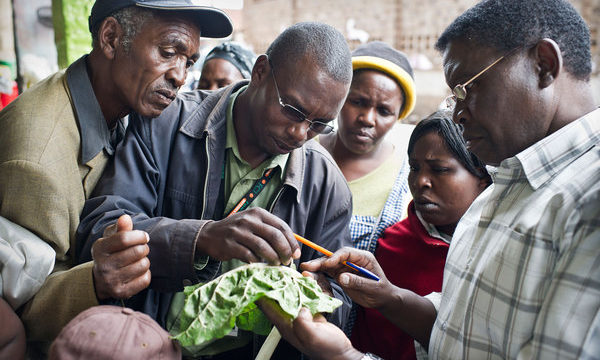Charis Cook works for GARNet, a BBSRC-sponsored network that supports plant scientists in the UK by, among other things, linking researchers to each other and to the research councils, and providing an information hub for plant scientists. GARNet also has its own blog. Before working for GARNet, Charis was at Royal Holloway, University of London, as a post-grad student and then a post-doctoral researcher.
Arabidopsis thaliana, an unassuming Brassicaceae species with a short life cycle and tiny white flowers, was the subject of nearly 4000 peer-reviewed journal articles in 2011. A. thaliana is also the starting point of much of the research featured on the Plantwise blog, as plant molecular biology depends heavily on resources built on research on this small plant.
In 2000, after ten years of research, A. thaliana became the first plant to have its genome fully sequenced. The following years were devoted to annotating the genome and building new resources around it, which now include transcriptome, proteome, and metabolome datasets, extensive information on protein interactions, hundreds of genotyped accessions, and germplasm banks. As a result, research into other plant species almost always involves, and often starts with, Arabidopsis resources. For example, the team who made the recent discovery of a rice gene that confers tolerance to phosphorus deficiency used Arabidopsis resources to make the initial identification of gene type and the function of its product; and the 2005 Golden Rice 2 team used an Arabidopsis phytoene synthase gene sequence to search the rice genome for novel copies of the gene.
An exciting piece of research that has the potential to reduce resource input into maize farming was highlighted on the Plantwise blog recently. Hartwig et al. predicted that the fungicide propiconazole would disrupt brassinosteroid biosynthesis, and tested their idea by spraying Arabidopsis plants with the fungicide. When they saw the resulting small plants and all-female flowers that were evidence of reduced brassinosteroid activity, the team tried it out on maize plants. Propiconazole-sprayed maize plants were also small with female flowers, but grain size and quantity were unaffected. As smaller plants require less water and fertiliser, and farmers usually remove male flowers to prevent self-pollination, propiconazole is an easy way of making maize farming more efficient. This project is an excellent demonstration of the other important property of Arabidopsis – it is cheap to buy and grow, and easy to maintain!
In the UK over the next few years, much biological research will be working toward a ‘digital organism,’ defined by the BBSRC as ‘collections of integrated models underpinned by quantitative data, which together represent key biological systems and processes.’ A. thaliana is a prime candidate for a ‘digital plant’ because of the extensive knowledge base that already exists for this species. It is not a crop species, but is nonetheless commercially very important. Historically A. thaliana researchers are the pioneers of plant science, leading the way for research on other species, and continued support of Arabidopsis research as we enter an era of bioinformatics-led plant research will be to the benefit all of plant and crop science.
2 Comments
Leave a Reply
Related News & Blogs
Inspiring Women in Science: An interview with Malvika Chaudhary
Science needs women and girls, but they continue to be overlooked. International Day of Women and Girls in Science aims to inspire women and girls to have greater representation in the field of science. CABI is proud of the invaluable contr…
1 February 2022



[…] the value of Arabidopsis, […]
[…] Note from Charis: You can see my guest post on the Plantwise blog here. […]